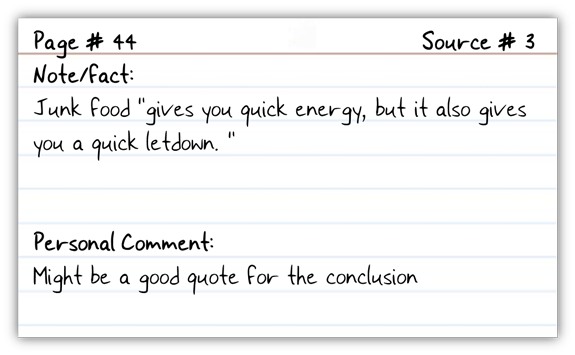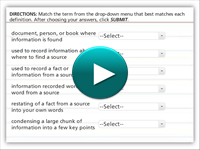
Note-taking, Paraphrasing, and Summarizing
 Now that you have a reliable source for information on your topic, you need to record it in your notes. A source is the book, website, document, or person containing the information you found and plan to use. Note-taking, when referring to research, involves more than simply writing down random facts. You have to be organized. Just like you need a plan when writing, you also need a plan when researching.
Now that you have a reliable source for information on your topic, you need to record it in your notes. A source is the book, website, document, or person containing the information you found and plan to use. Note-taking, when referring to research, involves more than simply writing down random facts. You have to be organized. Just like you need a plan when writing, you also need a plan when researching.
Source Cards
The first step is to collect information about your sources. Writing down the source information first will make it easier for you to come back and find that information or source later. One way to keep track of sources is to create source cards. A source card is an index card, whether physical or electronic, on which you record the author, title, publishing information, and location of each source. It is also helpful to number each card. If you do not have index cards, or prefer to use the computer, create a numbered list in a word-processing document. Just be sure to record the following information for each source, if it is available:
For a Print Source (book, magazine, journal)
- Author’s name
- Title of source
- Editor
- Name of the publisher
- City or state of the publisher
- Year of publication
- Page numbers on which the information is found
For an Electronic Source (web resources or online database):
For web sources, some information may not be provided (such as authors, dates, or page numbers). In these cases, identify as much information as possible while skipping missing information.
- Author’s name
- Document title
- Website title (NOT the URL)
- Publisher or sponsor of the site
- Date of electronic publication or last update
- Date you accessed the information on the electronic source
- Full URL
Below is an example of a source card for an electronic source:

Note-Taking and Note Cards
The second step in your research plan is to take notes. Once you have found information you want to use, you need to record it. You will need to keep this information organized as well, just like you did with your source cards. An excellent way to do this is to create note cards. Again, if you do not have index cards, or prefer to use the computer, create a numbered list in a word-processing document with the information that should appear on a note card. On note cards, you record one “fact” per index card with the source number in the corner. You should put the source number on each note card where information is used from that source. This will make it easier when you create your bibliography, or Works Cited page. The following information should be included on your note cards:
Source #: Using your source cards, write the number you applied to the source of the information.
Page #: Write on which page you found the information (if applicable). Not all sources will have page numbers available.
Note: Here is the note/fact itself.
Personal Comment: This is optional. It may be a reminder of where you want to put this in your paper or something similar.
Below is an example of a note card:

Quoting, Paraphrasing, and Summarizing
 There are three ways to do this: quote it, paraphrase it, or summarize it. In the interactivity below, click on each of the tabs to learn the differences among quoting, paraphrasing, and summarizing text and how to best apply these techniques in your writing. Click the player button to begin.
There are three ways to do this: quote it, paraphrase it, or summarize it. In the interactivity below, click on each of the tabs to learn the differences among quoting, paraphrasing, and summarizing text and how to best apply these techniques in your writing. Click the player button to begin.
Download a printable version of the interactivity above.
Note-taking, Paraphrasing, and Summarizing Review

![]() Knowing how to record information from and about the sources you plan to use in a research paper or project can make the process a lot easier. In addition, you need to know how to properly quote, paraphrase, and summarize that information. In the non-graded activity below, check to make sure you know some key concepts in note-taking and using information in your writing and projects. Match the term from the drop-down menu that best matches each definition. Once you have selected your answers, click SUBMIT. Click the player button to get started.
Knowing how to record information from and about the sources you plan to use in a research paper or project can make the process a lot easier. In addition, you need to know how to properly quote, paraphrase, and summarize that information. In the non-graded activity below, check to make sure you know some key concepts in note-taking and using information in your writing and projects. Match the term from the drop-down menu that best matches each definition. Once you have selected your answers, click SUBMIT. Click the player button to get started.


